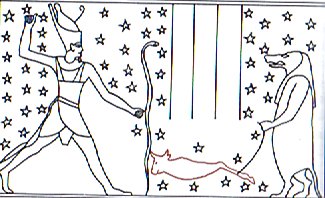6. Barthel has put a question mark at his translation of kai viri kai viri as 'unforgotten', and I guess the meaning could instead be connected with the horizon in the west, which the 3 islets presumably are indicating. Maybe their number (3) refers to 3 months of climbing up from the watery hole to winter solstice. There are 3 months of climbing from spring equinox to summer solstice and therefore there ought to be be 3 months of climbing also in the 'night'. Kai is presumably referring to the 'swallowing' at the horizon in the west and viri is also a recognizable sign:
The double kai viri in Manuscript E could indicate a 2nd 'swallowing', when not Spring Sun but the following Moon season is terminating, when the 'eye' of the year turns around as illustrated by Atua Mata Viri in Eb7-12:
To pick up fallen fruits (vili) is to bring the fallen up, and in the wheel of time what goes down must come up again. Perhaps it is accomplished by 'brandishing', and the gesture was used in ancient Egypt in connection with Pharaoh subduing his enemies:
Women find the gesture unnatural and difficult to perform, they will throw a ball from below instead of with arm stretched up. Vaha kai (as Metoro tended to say at the glyph type in question) can be regarded as a combination of viri with a double-rimmed oval:
Kai viri in Manuscript E could be the same type of sign as that which serves for my example of the glyph type vaha kai. The double kai viri kai viri would then be inscribed as a pair of vaha kai glyphs, e.g. thus:
In Bb9-20 there is no sign of viri, and possibly the glyph simply refers to the 'pool of tears' when Sun has vanished behind the rain clouds after midsummer. |






